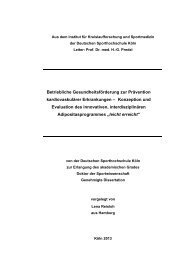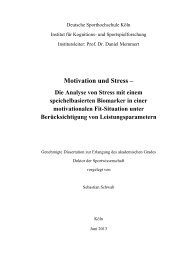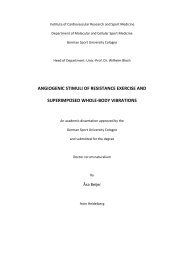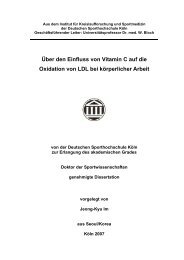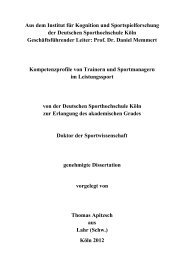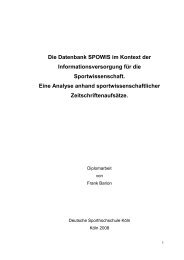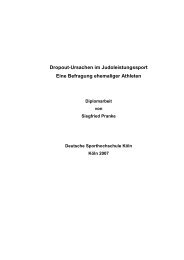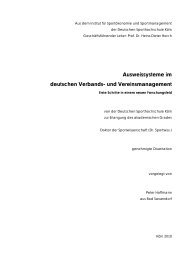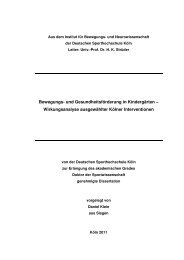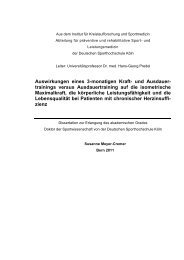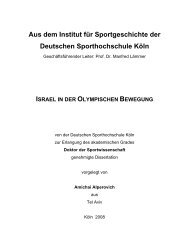- Seite 1 und 2:
Aus dem Institut für Sportökonomi
- Seite 3 und 4:
”Remember that all models are wro
- Seite 5 und 6:
Inhaltsverzeichnis II 4. Kritik ein
- Seite 7 und 8:
Inhaltsverzeichnis IV 7.2 Zur Schä
- Seite 9 und 10:
Inhaltsverzeichnis VI 12.2.8 FITNES
- Seite 11 und 12:
16.11.18 FILM .....................
- Seite 13 und 14:
Abkürzungsverzeichnis X ELES : Ext
- Seite 15 und 16:
Abkürzungsverzeichnis XII OLS m :
- Seite 17 und 18:
Abbildungsverzeichnis XIV Abbildung
- Seite 19 und 20:
Tabellenverzeichnis XVI Tab. 19 Hau
- Seite 21 und 22:
Tabellenverzeichnis XVIII Tab. 70 B
- Seite 23 und 24:
1. Einleitung 1 I: Einführung 1. E
- Seite 25 und 26:
1. Einleitung 3 erwartet: Das Vorha
- Seite 27 und 28:
2. Neoklassiche Nachfragetheorie 5
- Seite 29 und 30:
2. Neoklassiche Nachfragetheorie 7
- Seite 31 und 32:
2. Neoklassiche Nachfragetheorie 9
- Seite 33 und 34:
2. Neoklassiche Nachfragetheorie 11
- Seite 35 und 36:
2. Neoklassiche Nachfragetheorie 13
- Seite 37 und 38:
2. Neoklassiche Nachfragetheorie 15
- Seite 39 und 40:
2. Neoklassiche Nachfragetheorie 17
- Seite 41 und 42:
2. Neoklassiche Nachfragetheorie 19
- Seite 43 und 44:
2. Neoklassiche Nachfragetheorie 21
- Seite 45 und 46:
2. Neoklassiche Nachfragetheorie 23
- Seite 47 und 48:
2. Neoklassiche Nachfragetheorie 25
- Seite 49 und 50:
2. Neoklassiche Nachfragetheorie 27
- Seite 51 und 52:
3. Neoklassische Nachfragemodelle 2
- Seite 53 und 54:
3. Neoklassische Nachfragemodelle 3
- Seite 55 und 56:
3. Neoklassische Nachfragemodelle 3
- Seite 57 und 58:
3. Neoklassische Nachfragemodelle 3
- Seite 59 und 60:
4. Kritik einer rein neoklassischen
- Seite 61 und 62:
4. Kritik einer rein neoklassischen
- Seite 63 und 64:
4. Kritik einer rein neoklassischen
- Seite 65 und 66:
4. Kritik einer rein neoklassischen
- Seite 67 und 68:
4. Kritik einer rein neoklassischen
- Seite 69 und 70:
4. Kritik einer rein neoklassischen
- Seite 71 und 72:
4. Kritik einer rein neoklassischen
- Seite 73 und 74:
5. Modifizierte Nachfragemodelle f
- Seite 75 und 76:
5. Modifizierte Nachfragemodelle f
- Seite 77 und 78:
5. Modifizierte Nachfragemodelle f
- Seite 79 und 80:
5. Modifizierte Nachfragemodelle f
- Seite 81 und 82:
5. Modifizierte Nachfragemodelle f
- Seite 83 und 84:
6. Studien zur Nachfrage im FUK-Ber
- Seite 85 und 86:
6. Studien zur Nachfrage im FUK-Ber
- Seite 87 und 88:
6. Studien zur Nachfrage im FUK-Ber
- Seite 89 und 90:
6. Studien zur Nachfrage im FUK-Ber
- Seite 91 und 92:
6. Studien zur Nachfrage im FUK-Ber
- Seite 93 und 94:
6. Studien zur Nachfrage im FUK-Ber
- Seite 95 und 96:
6. Studien zur Nachfrage im FUK-Ber
- Seite 97 und 98:
6. Studien zur Nachfrage im FUK-Ber
- Seite 99 und 100:
6. Studien zur Nachfrage im FUK-Ber
- Seite 101 und 102:
6. Studien zur Nachfrage im FUK-Ber
- Seite 103 und 104:
6. Studien zur Nachfrage im FUK-Ber
- Seite 105 und 106:
6. Studien zur Nachfrage im FUK-Ber
- Seite 107 und 108:
6. Studien zur Nachfrage im FUK-Ber
- Seite 109 und 110:
6. Studien zur Nachfrage im FUK-Ber
- Seite 111 und 112:
6. Studien zur Nachfrage im FUK-Ber
- Seite 113 und 114:
6. Studien zur Nachfrage im FUK-Ber
- Seite 115 und 116:
6. Studien zur Nachfrage im FUK-Ber
- Seite 117 und 118:
6. Studien zur Nachfrage im FUK-Ber
- Seite 119 und 120:
6. Studien zur Nachfrage im FUK-Ber
- Seite 121 und 122:
6. Studien zur Nachfrage im FUK-Ber
- Seite 123 und 124:
6. Studien zur Nachfrage im FUK-Ber
- Seite 125 und 126:
6. Studien zur Nachfrage im FUK-Ber
- Seite 127 und 128:
6. Studien zur Nachfrage im FUK-Ber
- Seite 129 und 130:
6. Studien zur Nachfrage im FUK-Ber
- Seite 131 und 132:
6. Studien zur Nachfrage im FUK-Ber
- Seite 133 und 134:
6. Studien zur Nachfrage im FUK-Ber
- Seite 135 und 136:
6. Studien zur Nachfrage im FUK-Ber
- Seite 137 und 138:
6. Studien zur Nachfrage im FUK-Ber
- Seite 139 und 140:
6. Studien zur Nachfrage im FUK-Ber
- Seite 141 und 142:
6. Studien zur Nachfrage im FUK-Ber
- Seite 143 und 144:
6. Studien zur Nachfrage im FUK-Ber
- Seite 145 und 146:
6. Studien zur Nachfrage im FUK-Ber
- Seite 147 und 148:
6. Studien zur Nachfrage im FUK-Ber
- Seite 149 und 150:
6. Studien zur Nachfrage im FUK-Ber
- Seite 151 und 152:
6. Studien zur Nachfrage im FUK-Ber
- Seite 153 und 154:
6. Studien zur Nachfrage im FUK-Ber
- Seite 155 und 156:
7. Grundlagen zur Nachfragemodellsc
- Seite 157 und 158:
7. Grundlagen zur Nachfragemodellsc
- Seite 159 und 160:
7. Grundlagen zur Nachfragemodellsc
- Seite 161 und 162:
7. Grundlagen zur Nachfragemodellsc
- Seite 163 und 164:
7. Grundlagen zur Nachfragemodellsc
- Seite 165 und 166:
7. Grundlagen zur Nachfragemodellsc
- Seite 167 und 168:
7. Grundlagen zur Nachfragemodellsc
- Seite 169 und 170:
8. Nachfragemodellschätzung bei Nu
- Seite 171 und 172:
8. Nachfragemodellschätzung bei Nu
- Seite 173 und 174:
8. Nachfragemodellschätzung bei Nu
- Seite 175 und 176:
8. Nachfragemodellschätzung bei Nu
- Seite 177 und 178:
8. Nachfragemodellschätzung bei Nu
- Seite 179 und 180:
8. Nachfragemodellschätzung bei Nu
- Seite 181 und 182:
9. Datenbasis 159 Jahr 2004 (bzw. 2
- Seite 183 und 184:
9. Datenbasis 161 synonym verwendet
- Seite 185 und 186:
9. Datenbasis 163 9.2.2 Unabhängig
- Seite 187 und 188:
10. Datenauswertung 165 Tab. 15: Ve
- Seite 189 und 190:
10. Datenauswertung 167 10.2.1 Vari
- Seite 191 und 192:
10. Datenauswertung 169 einzelnen A
- Seite 193 und 194:
11. Deskriptive Statistik 171 troff
- Seite 195 und 196:
11. Deskriptive Statistik 173 Tab.
- Seite 197 und 198:
11. Deskriptive Statistik 175 Antei
- Seite 199 und 200:
11. Deskriptive Statistik 177 11.2.
- Seite 201 und 202:
11. Deskriptive Statistik 179 2005
- Seite 203 und 204:
11. Deskriptive Statistik 181 (1991
- Seite 205 und 206:
12. Mikrosimulationsmodelle im FUK-
- Seite 207 und 208:
12. Mikrosimulationsmodelle im FUK-
- Seite 209 und 210:
12. Mikrosimulationsmodelle im FUK-
- Seite 211 und 212:
12. Mikrosimulationsmodelle im FUK-
- Seite 213 und 214:
12. Mikrosimulationsmodelle im FUK-
- Seite 215 und 216:
12. Mikrosimulationsmodelle im FUK-
- Seite 217 und 218:
12. Mikrosimulationsmodelle im FUK-
- Seite 219 und 220:
12. Mikrosimulationsmodelle im FUK-
- Seite 221 und 222:
12. Mikrosimulationsmodelle im FUK-
- Seite 223 und 224:
12. Mikrosimulationsmodelle im FUK-
- Seite 225 und 226:
12. Mikrosimulationsmodelle im FUK-
- Seite 227 und 228:
12. Mikrosimulationsmodelle im FUK-
- Seite 229 und 230:
12. Mikrosimulationsmodelle im FUK-
- Seite 231 und 232:
12. Mikrosimulationsmodelle im FUK-
- Seite 233 und 234:
12. Mikrosimulationsmodelle im FUK-
- Seite 235 und 236:
12. Mikrosimulationsmodelle im FUK-
- Seite 237 und 238:
12. Mikrosimulationsmodelle im FUK-
- Seite 239 und 240:
12. Mikrosimulationsmodelle im FUK-
- Seite 241 und 242:
13. Anwendungsbeispiele 219 VII: In
- Seite 243 und 244:
13. Anwendungsbeispiele 221 lassen
- Seite 245 und 246:
13. Anwendungsbeispiele 223 i = i =
- Seite 247 und 248:
14. Schlussbetrachtung 225 Budgetan
- Seite 249 und 250:
14. Schlussbetrachtung 227 14.2 Zu
- Seite 251 und 252:
15. Literatur 229 15. Literatur Abd
- Seite 253 und 254:
15. Literatur 231 Baßeler, U., Hei
- Seite 255 und 256:
15. Literatur 233 Borland, J. & Lye
- Seite 257 und 258:
15. Literatur 235 Clark, J. B. (189
- Seite 259 und 260:
15. Literatur 237 Epple, D. (1987).
- Seite 261 und 262:
15. Literatur 239 Gratton, C. & Tay
- Seite 263 und 264:
15. Literatur 241 Howe, H. (1974).
- Seite 265 und 266:
15. Literatur 243 Kortmann, W. (200
- Seite 267 und 268:
15. Literatur 245 Loomes, G. & Sudg
- Seite 269 und 270:
15. Literatur 247 Mudambi, R. & Bau
- Seite 271 und 272:
15. Literatur 249 Pareto, V. (1896)
- Seite 273 und 274:
15. Literatur 251 Samuelson, P. A.
- Seite 275 und 276:
15. Literatur 253 Statistisches Bun
- Seite 277 und 278:
15. Literatur 255 UK Statistics Aut
- Seite 279 und 280:
15. Literatur 257 Winde, M. A. (200
- Seite 281 und 282:
16. Anhang 259 16.2 Private Konsuma
- Seite 283 und 284:
16. Anhang 261 Tab. 34: Ergebnisse
- Seite 285 und 286:
16. Anhang 263 16.6 Private Konsuma
- Seite 287 und 288:
16. Anhang 265 16.8 Probit-Modelle
- Seite 289 und 290:
16. Anhang 267 Tab. 41: Geschätzte
- Seite 291 und 292:
16. Anhang 269 Tab. 43: Geschätzte
- Seite 293 und 294:
16. Anhang 271 16.10 Working-Leser-
- Seite 295 und 296: 16. Anhang 273 16.10.3 KULTURDL Tab
- Seite 297 und 298: 16. Anhang 275 16.10.5 BAD Tab. 49:
- Seite 299 und 300: 16. Anhang 277 16.10.7 TANZ Tab. 51
- Seite 301 und 302: 16. Anhang 279 16.10.9 SKI Tab. 53:
- Seite 303 und 304: 16. Anhang 281 16.10.11 OPER Tab. 5
- Seite 305 und 306: 16. Anhang 283 16.10.13 KINO Tab. 5
- Seite 307 und 308: 16. Anhang 285 16.10.15 MUSEUM Tab.
- Seite 309 und 310: 16. Anhang 287 16.10.17 PAYTV Tab.
- Seite 311 und 312: 16. Anhang 289 16.11 Bedingte margi
- Seite 313 und 314: 16. Anhang 291 16.11.3 KULTURDL Tab
- Seite 315 und 316: 16. Anhang 293 16.11.5 BAD Tab. 67:
- Seite 317 und 318: 16. Anhang 295 16.11.7 TANZ Tab. 69
- Seite 319 und 320: 16. Anhang 297 16.11.9 SKI Tab. 71:
- Seite 321 und 322: 16. Anhang 299 16.11.11 OPER Tab. 7
- Seite 323 und 324: 16. Anhang 301 16.11.13 KINO Tab. 7
- Seite 325 und 326: 16. Anhang 303 16.11.15 MUSEUM Tab.
- Seite 327 und 328: 16. Anhang 305 16.11.17 PAYTV Tab.
- Seite 329 und 330: 16. Anhang 307 16.12 Budgetanteile
- Seite 331 und 332: 16. Anhang 309 Tab. 83: Demographis
- Seite 333 und 334: 16. Anhang 311 Tab. 85: Demographis
- Seite 335 und 336: 16. Anhang 313 16.14 Ausgabenelasti
- Seite 337 und 338: 16. Anhang 315 Tab. 89: Demographis
- Seite 339 und 340: 16. Anhang 317 Tab. 91: Demographis
- Seite 341 und 342: 16. Anhang 319 16.16 Ausgabenelasti
- Seite 343 und 344: 16. Anhang 321 Tab. 95: Demographis
- Seite 345: 18. Kurzzusammenfassung 323 18. Kur




